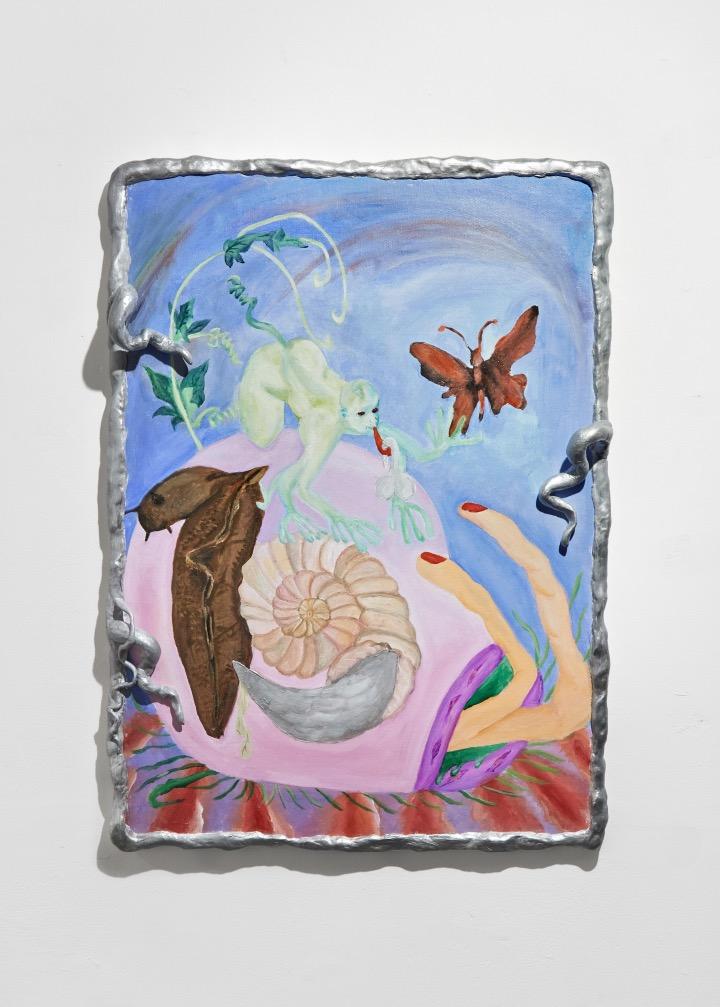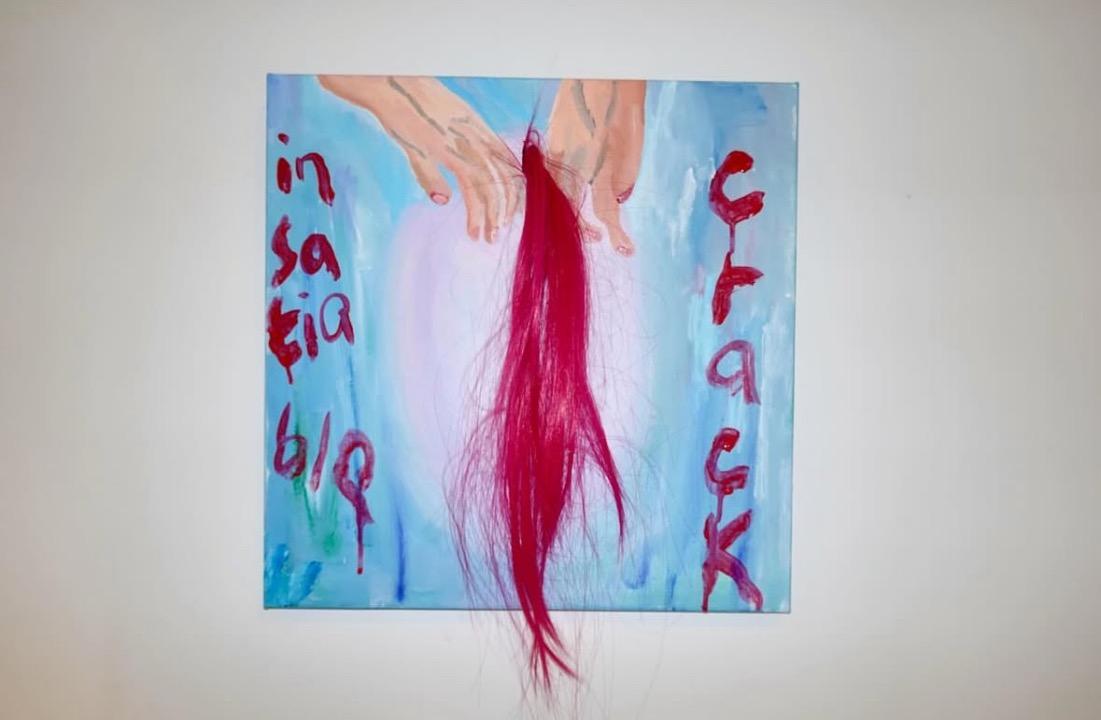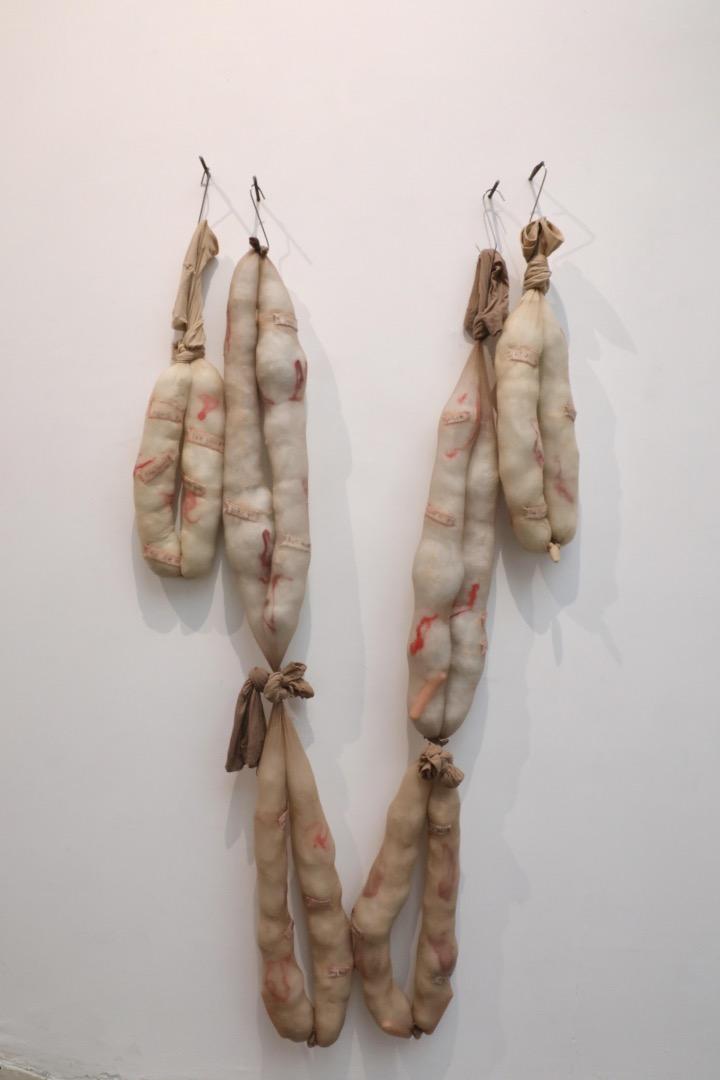Jingyun Guan (b. 2001) is a Chinese artist based in London. Since beginning their practice in 2019, they have moved fluidly across media, evolving from photography into fine art. Their 2024 series marks a significant point in their creative trajectory, offering a deeply personal yet theoretically engaged body of work. Here, Guan transforms personal trauma into artistic expression, exploring body politics, gender identity, and cultural belonging with a distinctly poetic sensibility.
The roots of Guan’s 2024 series reach back to their adolescence. As a melancholic teenager walking two kilometers home from school each day, a chance encounter with a rotting sausage by the roadside became the unlikely seed for what would later grow into On My Way Home, a central work in the current series.

On My Way Home exemplifies Guan’s material approach. Tights, cotton wool, meat hooks, and silicone — everyday materials — take on layered symbolic significance. Flesh-toned, vascular forms appear both animate and suspended, reminiscent of medical specimens, while womb-like contours evoke both safety and abandonment. Guan sets up stark material contrasts: soft hosiery against cold steel hooks, warm flesh tones beside sharp edges. In this tension, the fragility and resilience of embodied existence emerge.

This sensitivity to material recurs throughout the series. Guan gravitates towards skin-like textures that simultaneously invite touch and suggest danger. In The Queer Goddess’s Body, melted candle wax drips onto tights; in Growing New Hand from the Nerves, a wax palm appears to sprout from red silk. Across these works, Guan sustains a dialogue between tenderness and severity.
The Queer Goddess’s Body carries this conversation into even more layered registers. The work features the head of an infant toy adorned with drag makeup, atop a body of tights stuffed with cotton wool — innocent yet provocative, fragile yet powerful. Beyond simply challenging gender norms, Guan dissolves boundaries between the sacred and profane, purity and desire. Divinity, in their vision, transcends human gender categories, becoming something more inclusive and fluid.

Color operates as an emotional register across these works. Flesh pink evokes bodily warmth and vulnerability; blood red signals both trauma and passion; pure white hints at purification and rebirth. In Date With The Snail, these chromatic strategies deepen: dreamlike blue-purple backgrounds meet warm-toned organic forms, producing a surreal intimacy. Referencing Zhuangzi’s “butterfly dream,” Guan blurs the lines between reality and illusion.

The series also sustains what Guan calls a “childish style.” Yet this is no naïve aesthetic. In An Insatiable Crack, for instance, a red fissure reads both as wound and portal. Guan writes: “My hand passes through your hair, leaving ghostly touch; I pass through your body, opening a crack in my body…” — revealing a nuanced understanding of intimacy as both penetration and vulnerability, possession and surrender.
Throughout their work, Guan employs a distinct “metamorphic aesthetic.” From the fleshy forms of On My Way Home, to the suspended limbs in Pose Pose Pose, to hybrid creatures across their paintings, they deploy transformation and recombination, creating forms thwhatat are simultaneously familiar and unsettling. This metamorphosis does not seek sensationalism but disrupts fixed ways of seeing, inviting viewers into a space of cognitive ambiguity.
In their performance My Mom’s Home, Guan extends personal narrative into cultural reflection. Through bodily movement, they navigate the entangled love-hate dynamics of mother-daughter relationships within East Asian contexts — patterns of emotional interdependence that resonate not only in family but also in their cultural positioning as a Chinese artist working within Western art discourse.
What distinguishes Guan’s practice is their ability to transform intimate experiences into works that carry universal resonance. Within contemporary queer art, Guan’s voice offers a distinct contribution. Drawing on both material and bodily sensitivity, they infuse their work with Eastern poetics. Their practice reminds us that identity is never fixed but multiple, fluid, and open to possibility. In navigating the tensions between tenderness and severity, Guan exemplifies how contemporary art can confront the complexities of lived reality.

